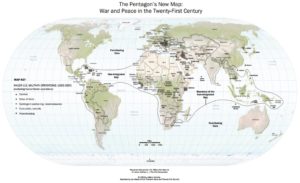The Crisis Era in Core versus Gap Terms
 In my last post I reviewed the strategic theory of Thomas P. M. Barnett. Now I want to look at the current Crisis Era in the U.S., particularly the recent political upheaval, and how it can be described from the perspective this theory provides. Luckily, Barnett himself does so in a blog post. What follows is my own summary.
In my last post I reviewed the strategic theory of Thomas P. M. Barnett. Now I want to look at the current Crisis Era in the U.S., particularly the recent political upheaval, and how it can be described from the perspective this theory provides. Luckily, Barnett himself does so in a blog post. What follows is my own summary.
Mission Aborted
The end of the Cold War saw the United States emerge as the global hegemon and sole superpower. The U.S. system of free market capitalism had prevailed over the statist central planning system of the U.S.S.R. An important factor was swinging the emerging New Core state of China toward the U.S. system.
In the new order, the world of superpower-led blocs transformed into a world of Core states (integrated, stable) and Gap states (non-integrated, unstable). Guiding the integration of the Gap into the Core in concert with the world’s other Great Powers was the new mission of the United States. In this way, threats emerging from the Gap could be contained and capital could flow freely to where it would do the most good for humanity.
This task proved to be beyond the creative capacity of the nation. Hampered by a dysfunctional political system and hung-up on old strategic paradigms, the United States abandoned the mission. It gave up its world leadership role, turning inward to nurse her grievances. The Globalization III era came to an end.
While the U.S. sorts out its internal issues, violence rages in the Gap, and authoritarian and nationalist movements make headway around the world.